
current / archive / issues / faq / RSS feed / twitter /
Interlude
| < previous | next > |
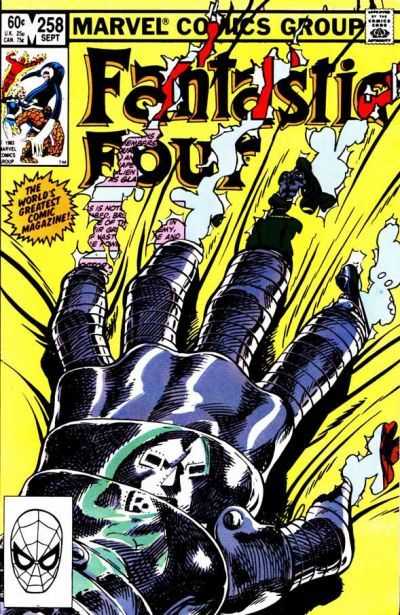 A few weeks ago we looked at This Land Is Mine! in FF247, a story where John Byrne brought together strands of Doctor Doom continuity from the previous twenty years in order to place his own stamp on the character. It was a masterful use of the possibilities of creating new stories within a massive, long-running storyworld, but in terms of continuity the comic we're looking at today makes it look like an issue of Spidey Super Stories!
A few weeks ago we looked at This Land Is Mine! in FF247, a story where John Byrne brought together strands of Doctor Doom continuity from the previous twenty years in order to place his own stamp on the character. It was a masterful use of the possibilities of creating new stories within a massive, long-running storyworld, but in terms of continuity the comic we're looking at today makes it look like an issue of Spidey Super Stories!
This blog took me longer to write (by a LONG way) than any other up to this point, because it's a concerted attempt by John Byrne to gather together as many recent (and not so recent) Doctor Doom stories as he possibly can and hammer them together into a single coherent storyline that he is in control of. It reminded me of the games fans play trying to make it all make sense, or indeed recent series like History Of The Marvel Universe or X-Men: Grand Design, where creators tried to force every single piece of comics history into a single unified, sensible, narrative. For the most part those series worked more as illustrated encyclopedias, bringing events together through narration and montage, but here John Byrne weaves it all together in a single story, often using quotation of images and dialogue to link past events together. It's a bold, quite experimental, move, for a mainstream superhero comic, and while it doesn't quite match "This Land Is Mine" for narrative daring or character redefinition, it's a very satisfying one to play "spot the references" with.
The experimentation starts with the front cover, which sees Doom ripping apart the cover to reveal something else underneath. I wonder how Byrne achieved this? The bits of the splash page we see revealed on the cover do match up exactly with what's beneath, including the inking, and lettering (see below), and whereas nowadays this would be easy to do this using computers, back then I guess the original artwork would have had to been cut through and then laid over the lettered version of the first page.
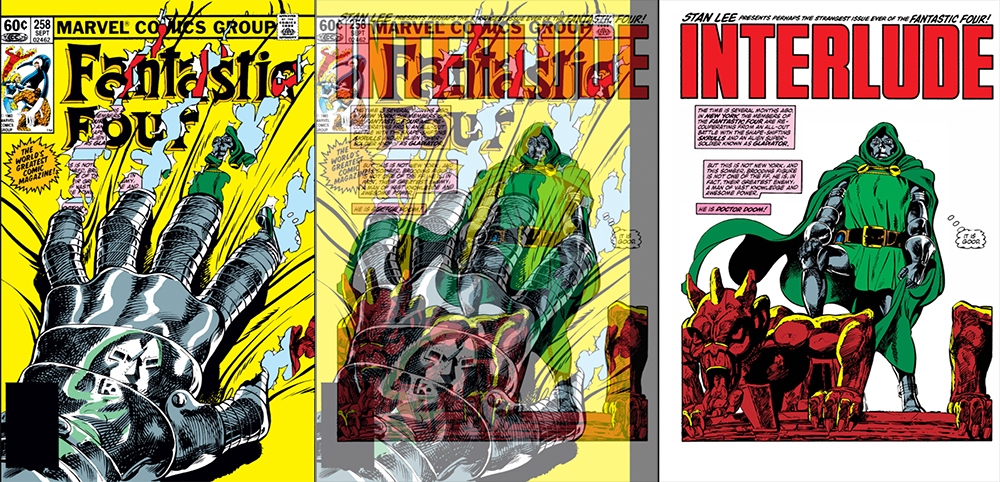 The idea of the cover being torn is not new - a very famous example is the new X-Men bursting through the original version of the team in Giant Size X-Men #1 - but here the action of destruction is coming from outside the comic, rather from within. Doom is not escaping from inside the comic, he's breaking it from the outside so that we can see behind the usual imagery and get a look at something we wouldn't see - much like the story itself.
The idea of the cover being torn is not new - a very famous example is the new X-Men bursting through the original version of the team in Giant Size X-Men #1 - but here the action of destruction is coming from outside the comic, rather from within. Doom is not escaping from inside the comic, he's breaking it from the outside so that we can see behind the usual imagery and get a look at something we wouldn't see - much like the story itself.
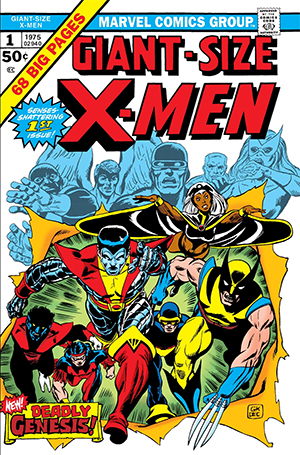 This issue of "The Fantastic Four" does not feature the FF at all. It's an entire comic dedicated solely to Doctor Doom and what he's been up to over the past few months, often in the background of other stories. In some ways this is a comics version of what this blog has been trying to do - seeing if there's a single Doctor Doom storyline that has been told within (and often between) different texts without breaking through into it's own comic ... until now.
This issue of "The Fantastic Four" does not feature the FF at all. It's an entire comic dedicated solely to Doctor Doom and what he's been up to over the past few months, often in the background of other stories. In some ways this is a comics version of what this blog has been trying to do - seeing if there's a single Doctor Doom storyline that has been told within (and often between) different texts without breaking through into it's own comic ... until now.
Having Doctor Doom as the lead character is not new either of course. He had his own series back in Astonishing Tales and Super-Villain Team-Up, and he's taken over large portions the FF's series too, such as when his origin story was first told in Fantastic Four Annual #2 or the focus on his many machination in Fantastic Four # 87. That means this isn't quite "the strangest issue ever of The Fantastic Four" as promised on the splash page, but it's certainly the most reference-heavy that I've ever read!
The referencing starts with pages two and three, a double page spread showing Doomstadt being repaired, which instantly recalls the ruined city we saw in the similar spread in "This Land Is Mine".
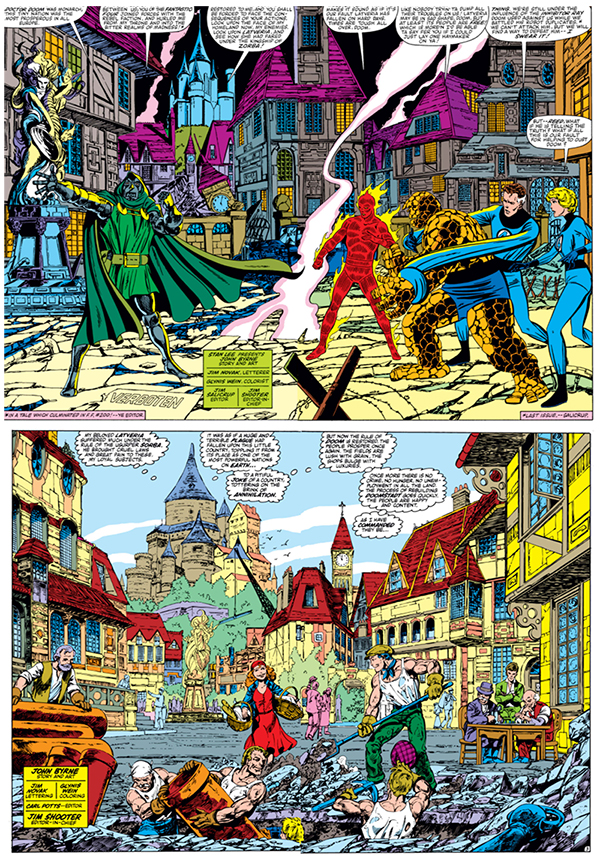 Interestingly, the castle in the background has changed from the slender version earlier to a direct copy of the Jack Kirby version first seen in Fantastic Four #87 (and then Spidey Super Stories #19) and more recently in The Official Handbook To The Marvel Universe. It seems that this version is taking over from the Frank Miller castle that has been the standard for some time.
Interestingly, the castle in the background has changed from the slender version earlier to a direct copy of the Jack Kirby version first seen in Fantastic Four #87 (and then Spidey Super Stories #19) and more recently in The Official Handbook To The Marvel Universe. It seems that this version is taking over from the Frank Miller castle that has been the standard for some time.
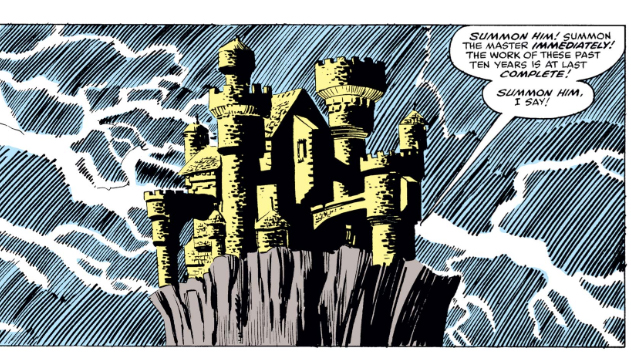 Byrne adds another detail which makes it clear (to those who are super-familiar with his run on this series anyway) that this is definitely meant to be the same location as in the earlier comic - in the background we can see the same statue that Doom was standing in front of when he first confronted the FF with the results of Zorba's rule.
Byrne adds another detail which makes it clear (to those who are super-familiar with his run on this series anyway) that this is definitely meant to be the same location as in the earlier comic - in the background we can see the same statue that Doom was standing in front of when he first confronted the FF with the results of Zorba's rule.
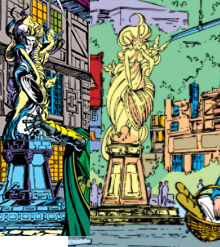 The workers in the foreground, who echo the positions of the FF in the previous version, are notably happy about their work. This is in marked contrast to other occasions when Latverian workers have had to rebuild their town, such as in Astonishing Tales #4 or the Spider-man cartoon series.
The workers in the foreground, who echo the positions of the FF in the previous version, are notably happy about their work. This is in marked contrast to other occasions when Latverian workers have had to rebuild their town, such as in Astonishing Tales #4 or the Spider-man cartoon series.
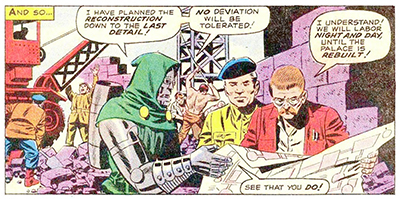
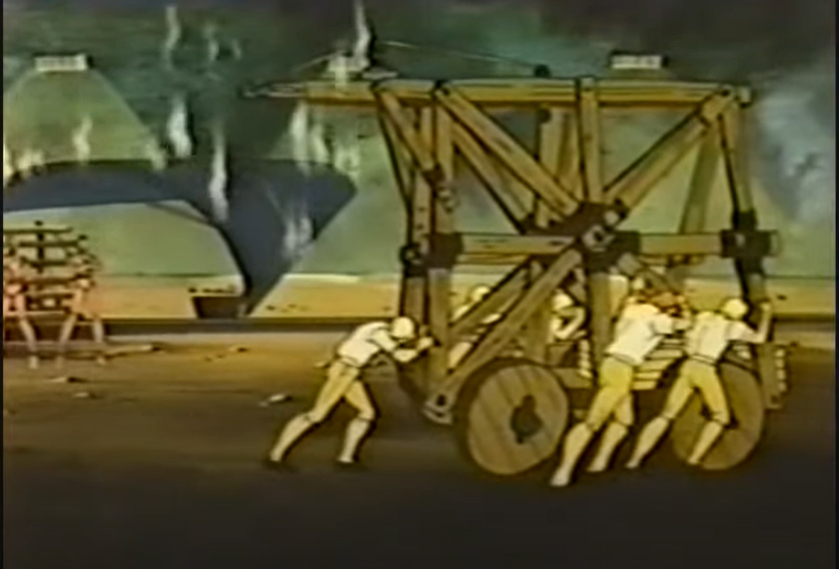 The continuity continues on the next page, where Doom is visited by a gipsy girl with news from the outside world.
The continuity continues on the next page, where Doom is visited by a gipsy girl with news from the outside world.
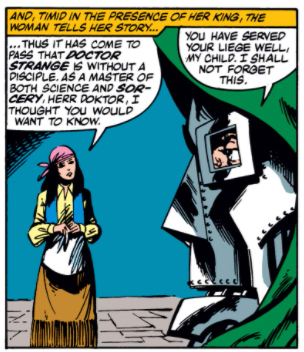 If this exchange seems eerily familiar that's because it's an exact retelling of a scene we saw very recently in Doctor Strange #57.
If this exchange seems eerily familiar that's because it's an exact retelling of a scene we saw very recently in Doctor Strange #57.
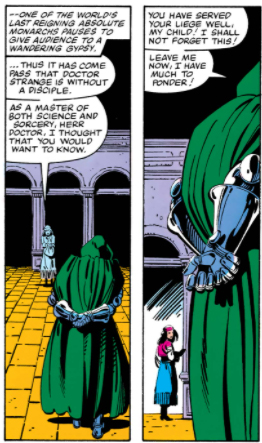 I don't know if this was a mutual decision between John Byrne and Roger Stern (the writer of Doctor Strange) or Byrne just did it without consoltation, but the pair would collaborate like this a couple of years later on Fantastic Four Annual #19 and Avengers Annual #14, when the same story was told from the perspective of each team, with several scenes being duplicated.
I don't know if this was a mutual decision between John Byrne and Roger Stern (the writer of Doctor Strange) or Byrne just did it without consoltation, but the pair would collaborate like this a couple of years later on Fantastic Four Annual #19 and Avengers Annual #14, when the same story was told from the perspective of each team, with several scenes being duplicated.
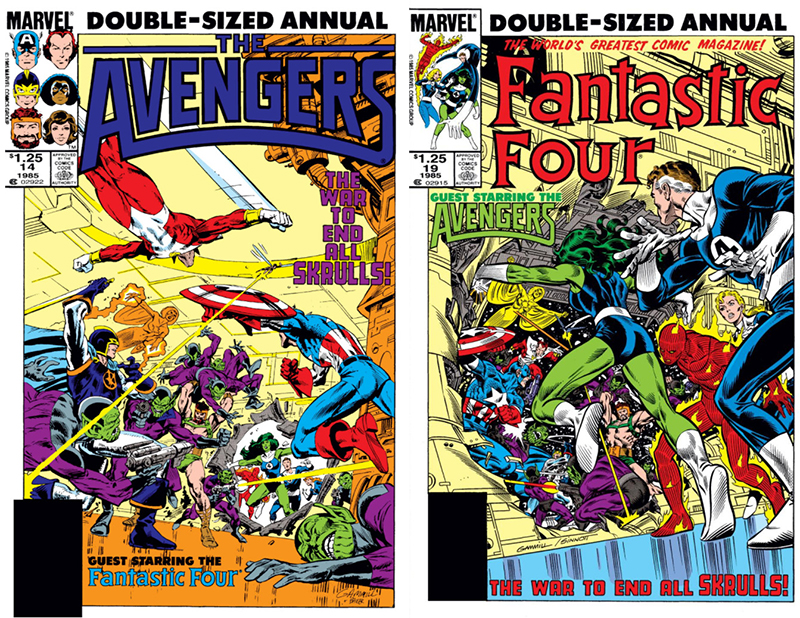 The continuity keeps on coming as we catch up with Kristoff, the young boy whose mum was killed back in This Land Is Mine! It turns out that Doom has adopted the child as his ward, and we follow the pair as they go on a tour of the castle where Doom (or rather John Byrne) catches up on even more continuity. This time it's Uncanny X-Men 146, which saw Doom teaming up with Arcade. Apparently John Byrne felt that Chris Claremont, scripter on this and so many other issues of X-Men, did not write Doom properly, notably allowing Arcade to strike a match off his armour, so retcons the whole storyline so that it was a robot, not Doom, who was involved.
The continuity keeps on coming as we catch up with Kristoff, the young boy whose mum was killed back in This Land Is Mine! It turns out that Doom has adopted the child as his ward, and we follow the pair as they go on a tour of the castle where Doom (or rather John Byrne) catches up on even more continuity. This time it's Uncanny X-Men 146, which saw Doom teaming up with Arcade. Apparently John Byrne felt that Chris Claremont, scripter on this and so many other issues of X-Men, did not write Doom properly, notably allowing Arcade to strike a match off his armour, so retcons the whole storyline so that it was a robot, not Doom, who was involved.
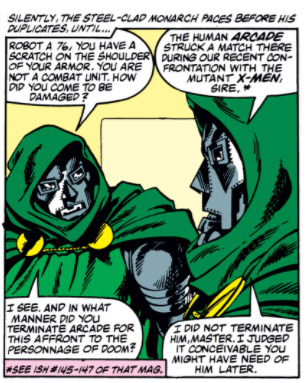 Doom destroys the robot for suggesting he would "need" anyone... and John Byrne basically gets to throw his weight around a bit, demonstrating that Doom is his character, so he has final say on how he acts. This whole issue is an exercise in ownership, with Byrne bringing as many previous Doom stories into his own series, partly to show that we're looking at the one true Doom here, but also to say that he himself is the one true author of the character.
Doom destroys the robot for suggesting he would "need" anyone... and John Byrne basically gets to throw his weight around a bit, demonstrating that Doom is his character, so he has final say on how he acts. This whole issue is an exercise in ownership, with Byrne bringing as many previous Doom stories into his own series, partly to show that we're looking at the one true Doom here, but also to say that he himself is the one true author of the character.
We follow Doom and Kristoff for the rest of the day, including an appearance by one of the Latverian policemen from Fantastic Four Annual #2, before cutting to the next morning, where Doctor Doom's breakfast is disturbed by a message from Hauptmann, the long serving/suffering scientist who we last saw reviving Doom in Fantastic Four Annual #15. This leads to a recap of the storyline which began in Fantastic Four #57 where Doom stole the power of The Silver Surfer - a recap which features more of Byrne's redrawings of Kirby panels from a different viewpoint.
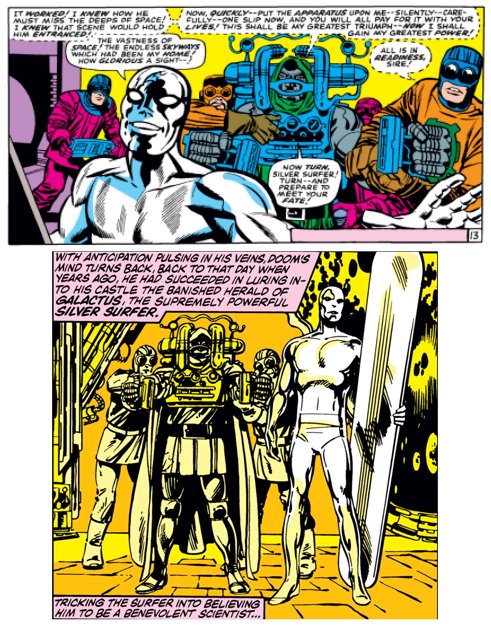 It turns out that Doom still has access to the Surfer's power, and has had Hauptmann working on a way to transfer it into another body. Hauptmann invites Doom to use the machine to empower himsefl, but Doom is having none of it and insists the scientist has first go... with predictable results.
It turns out that Doom still has access to the Surfer's power, and has had Hauptmann working on a way to transfer it into another body. Hauptmann invites Doom to use the machine to empower himsefl, but Doom is having none of it and insists the scientist has first go... with predictable results.
 Byrne thus ties up the long-running saga of the Hauptmann brothers by having this one finally attempt to take revenge on Doom for murdering his sibling way back in Fantastic Four #87.
Byrne thus ties up the long-running saga of the Hauptmann brothers by having this one finally attempt to take revenge on Doom for murdering his sibling way back in Fantastic Four #87.
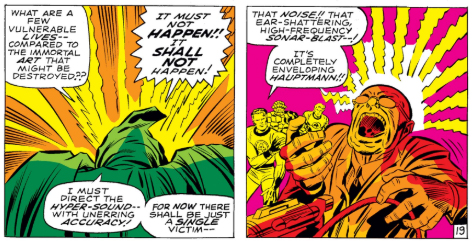 I did say there was a lot of continuity references in this comic didn't I? We get a very brief respite from it now though, as Kristoff returns to say goodnight. He makes the dangerous mistake of telling Doom that he's read somewhere that Magneto's power rivals his own. Doom snaps at this (despite the fact that poor old Kristoff only said that he'd read it) and lifts the boy up by the scruff of his neck to give him a right telling off before sending him to bed.
I did say there was a lot of continuity references in this comic didn't I? We get a very brief respite from it now though, as Kristoff returns to say goodnight. He makes the dangerous mistake of telling Doom that he's read somewhere that Magneto's power rivals his own. Doom snaps at this (despite the fact that poor old Kristoff only said that he'd read it) and lifts the boy up by the scruff of his neck to give him a right telling off before sending him to bed.
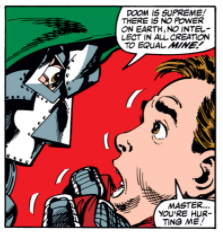 With his parental duties done (badly) Doom returns to the issue of the power cosmic, with a cunning scheme to find a new host powerful enough to be able to handle it. This involves, of course, even more continuity as he sends some Doombots off to New York, where they sneak around a hospital looking for a specific patient. As we should be able to guess by now, this is not just any hospital but instead the very same one where The Thing was a patient recently in Marvel Two-In-One #96.
With his parental duties done (badly) Doom returns to the issue of the power cosmic, with a cunning scheme to find a new host powerful enough to be able to handle it. This involves, of course, even more continuity as he sends some Doombots off to New York, where they sneak around a hospital looking for a specific patient. As we should be able to guess by now, this is not just any hospital but instead the very same one where The Thing was a patient recently in Marvel Two-In-One #96.
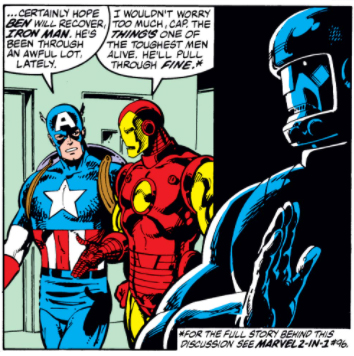 It strikes me that Byrne may have asked for a list of all Doom's recent appearances, and chanced upon this one as a nice way to link the hospital visit in too. In fact, Byrne's managed to rope in pretty much every major Doom appearance (ignoring flashbacks and single panel cameos) from the last three years, with the only ones missing being "Doomquest" in Iron Man and his two issues of Dazzler. Having said that, both of those storylines were already tied into the loose "The Return Of Doctor Doom" storyline. so maybe he thought they were already covered.
It strikes me that Byrne may have asked for a list of all Doom's recent appearances, and chanced upon this one as a nice way to link the hospital visit in too. In fact, Byrne's managed to rope in pretty much every major Doom appearance (ignoring flashbacks and single panel cameos) from the last three years, with the only ones missing being "Doomquest" in Iron Man and his two issues of Dazzler. Having said that, both of those storylines were already tied into the loose "The Return Of Doctor Doom" storyline. so maybe he thought they were already covered.
The robots find the patient they're looking for and take him back to Latveria, where he's revealed to be Terrax, recovering from his dismissal from Galactus's service in Fantastic Four #243. There's a triple whammy of continuity here, as not only does Byrne refer back to his own story, but also to Terrax's original origin story as Tyros The Tyrant from Fantastic Four #211 AND to the naming of his planet and people in The Official Handbook Of The Marvel Universe #6. It was here in the handbook, apparently, that his planet was named Lanlak and his people the Birj, although it may be that Byrne himself chose the names and told the Handbook compilers he'd been doing this in advance.
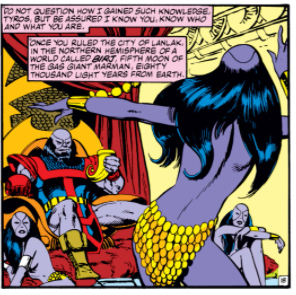 Doom has selected Terrax/Tyros to be the bearer of the power cosmic because a) he's used it before and b) he hates the Fantastic Four, so charges him up and sends him off for a big fight in the next issue. One of the Doombots (who clearly hasn't seen what happens to people who question Doom's schemes) suggests that this might be a bit daft, as Tyros now has the power cosmic and could very easily use it to take over the world himself, but Doom reacts much more calmly than previously - possibly because he was waiting for the chance to show off about how clever he's been.
Doom has selected Terrax/Tyros to be the bearer of the power cosmic because a) he's used it before and b) he hates the Fantastic Four, so charges him up and sends him off for a big fight in the next issue. One of the Doombots (who clearly hasn't seen what happens to people who question Doom's schemes) suggests that this might be a bit daft, as Tyros now has the power cosmic and could very easily use it to take over the world himself, but Doom reacts much more calmly than previously - possibly because he was waiting for the chance to show off about how clever he's been.
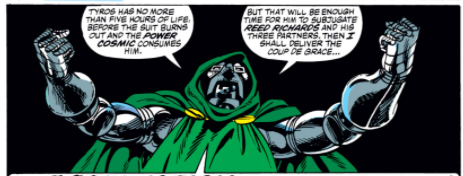 Tyros only has five hours to live, whatever happens, so will be no threat to Doom! The cunning rotter!!
Tyros only has five hours to live, whatever happens, so will be no threat to Doom! The cunning rotter!!
And that - at last - is the end of the comic. As I said at the beginning, this blog took me far and away the longest to write out of all of them so far, purely because it's packed so tight with references. It's been a fascinating (for me) examination of all the work that Byrne's put in here to claim Doom as his own, possibly in preparation for the changes that are on the way soon. It is, in fact, his way of saying "This Character Is Mine!"
link to information about this issue
posted 3/11/2020 by Mark Hibbett
| < previous | next > |
Comments: